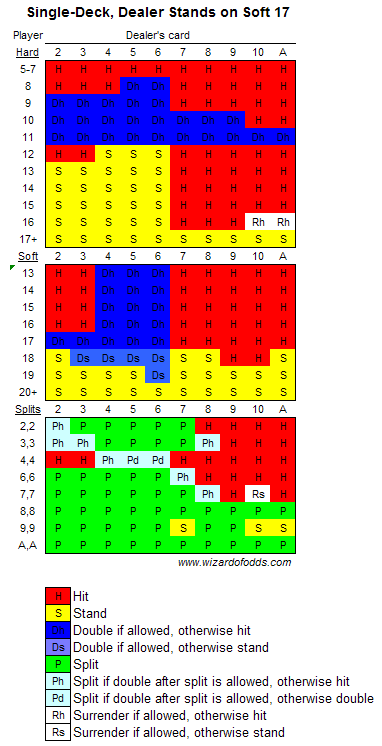This blackjack calculator will help teach you the correct play to make for every scenario possible. Our advanced algorithm allows you to customize different table rules so you can make the best informed decision to beat the house.
- One of the most important things to master in the game of blackjack is knowing when to hit or stand. To ‘hit’ means to request another card in order to get your total closer to 21. To ‘stand’ means to forfeit the option of taking another card because your hand is already equal to 21 or as close to 21 as it can be -in this case, the risk.
- Nonetheless, we have listed some handy basic blackjack terminology below: Stand. The player stays with the cards they were dealt. The player is dealt another card, and they can be dealt more if they wish. If the total of the cards exceeds 21 at any point, the player is bust and loses the hand.
- There's a reasonable chance the dealer will go bust, and he will be lucky if he finishes in the 17-21 zone. If you've got 13 or more then stand. Hit on 12 or less. This is bad for the dealer! Don't risk going bust. Hit on 11 or less.
It will calculate the best possible option depending on the criteria by telling you the best statistical play: Whether to Hit, Stand, Surrender, Double or Split.
How to use this blackjack calculator
- Click to choose the dealer’s upcard
- Click on your first and second cards
- Click on calculate
- Click on reset to start over
- Click on clear to reset only your cards

The Blackjack dealer in the trainer will then proceed to deal out both your cards as well as his. Your cards are always dealt face up. However, only one of the dealer’s cards will be dealt face up and the score of the dealer’s hole card won’t be visible to you. Split, Hit, Stand.

Once you’ve practiced long enough with our calculator, move on to the next step of how to count cards using the hi-lo method so you can take your new found skills and play blackjack for real money.
Why is this the best blackjack calculator?
After looking around at other blackjack sites, we saw how complicated their blackjack calculators were and outdated they looked. If you’re a beginner, you’ll most likely get confused and never want to try again. So we made the user interface easy to follow and gave it a modern look.
What is the house edge in blackjack?
The casino has a house edge of 8% against players. By incorporating disciplined strategy, you can lower this down to as little as 0.5%, depending on what the table rules are. This is done by utilizing proper techniques when doubling down and splitting at the right moments.

Now that you understand blackjack odds and the correct play, it’s now time for you to play online blackjack at our top online casinos.
The entire game of blackjack is based around the two words “Hit me”. All of the strategy and logic in the game comes down to whether or not you want to get another card added on top of your first two cards. Remember, the goal of blackjack is to either make the dealer bust, hit 21 yourself, or have a higher number than the dealer ends up with.
Most of the variance in the game comes from the idea of hitting or standing when you either get another card dealt to you, at risk of busting, or stay where you are, and risk the dealer beating you. This is a complex decision making process, and it’s important to know how to approach it.
This page details all of the methods you can use to understand when to hit or stand, and at the end, you can find a chart explaining why. Let’s jump right into it with a discussion of the dealer’s up card and why that matters.
Knowing When To Hit Or Stand - The Dealer’s Up Card
Understanding the implications of the dealer’s up card is very important. Basically, you get to see one of the dealer’s cards, and that allows you to make some guesses as to what number they are at, and what their decision making process will be. The higher the dealer’s up card, the more likely the player is to want to hit, as a general rule. This is because, once again, the goal is to beat the dealer - to get the closest to 21 without going over. The card you see tells you a lot about the range of possibilities they could have. For example, if you see a 2, you know that their total is relatively low, and if you have a decent total, it could be correct to stand. That’s the basics of understanding a dealer’s up card, but there’s so much more to understand what the process is behind choosing to stand.
Blackjack When To Stay
When To Stand In Blackjack
The basic idea of when you want to stand in blackjack is when you have a pretty good idea that your total is pretty close to 21, you don’t want to risk going over, and you want to put the onus on the dealer to beat your total. This tends to mean that you want to start seriously considering standing at around 17 total. The idea here is that, unless you can see an ace from the dealer, you’re fairly likely to have more than them at this point, given the amount of times cards that are worth more than 7 appear in the deck. If you have 19, you’re always standing, for example. You’re likely to bust if you hit, and it’s relatively hard to beat. The rules for this are fairly fluid so understand them well.
When To Hit In Blackjack
The basic idea behind when you want to hit in blackjack is twofold. First, you want to hit when you aren’t in much danger of going over or busting. Second, you want to hit when you need to beat a decent dealer total. This means that if you have a middling hand, let’s say 15, you’ll want to stand if the dealer’s face up card is fairly low, but hit if the dealer’s face up card is higher. This is because you can extrapolate the range of possible outcomes from the dealer’s face up card, and understand when you need to hit, and when you need to stand. There’s a lot of math that goes into this, but you can play by intuition as well. Remember, the goal of the game is to beat the dealer without going over - and that’s devilishly simple, but devilishly tricky as well.
When Does The Dealer Have To Hit In Blackjack
The basic rules that most dealers follow, across the board, are determined to their mathematical advantage over years of study and play. The dealer will always hit on anything below a 16 total. This is why, when you have a 17, you tend to consider staying - you have something fairly close to what they tend to stay at. This can get a little more complex when people start considering aces, which allow the concept of hard and soft 17s to enter the equation, but that’s mostly a discussion for a different page. Suffice to say, the basic rule they follow is that they will hit anything that is a 16 total or below.
When Does The Dealer Have To Stay In Blackjack
Dealers in blackjack follow strict rules - rules that are designed for them to play as optimally as possible against you. The basic idea behind most of them is to optimize their mathematical odds at victory. For this reason, almost all dealers will stand when their total is 17 or above. As before, aces throw a bit of a wrench into this equation, but there is a lot of grey area in Blackjack. The basic rule they follow is to stand on 17 because that puts the onus on you to beat a 17, which is pretty hard to do without going over.

Hit Or Stand Cheat Sheets
When To Hit And When To Stay In Blackjack
Here is a very basic legal blackjack hit or stand cheat sheet. Remember that the math changes depending on which type of blackjack you’re playing, so make sure you understand what’s going on in each variant you play.
When To Hit And Stay In Blackjack
| Your Hand | Up Card | |||||||||
| 2 | 3 | 4 | 5 | 6 | 7 | 8 | 9 | 10 | A | |
| <11 | Hit | Hit | Hit | Hit | Hit | Hit | Hit | Hit | Hit | Hit |
| 12 | Hit | Hit | Stand | Stand | Stand | Hit | Hit | Hit | Hit | Hit |
| 13 | Stand | Stand | Stand | Stand | Stand | Hit | Hit | Hit | Hit | Hit |
| 14 | Stand | Stand | Stand | Stand | Stand | Hit | Hit | Hit | Hit | Hit |
| 15 | Stand | Stand | Stand | Stand | Stand | Hit | Hit | Hit | Hit | Hit |
| 16 | Stand | Stand | Stand | Stand | Stand | Hit | Hit | Hit | Hit | Hit |
| 17-21 | Stand | Stand | Stand | Stand | Stand | Stand | Stand | Stand | Stand | Stand |